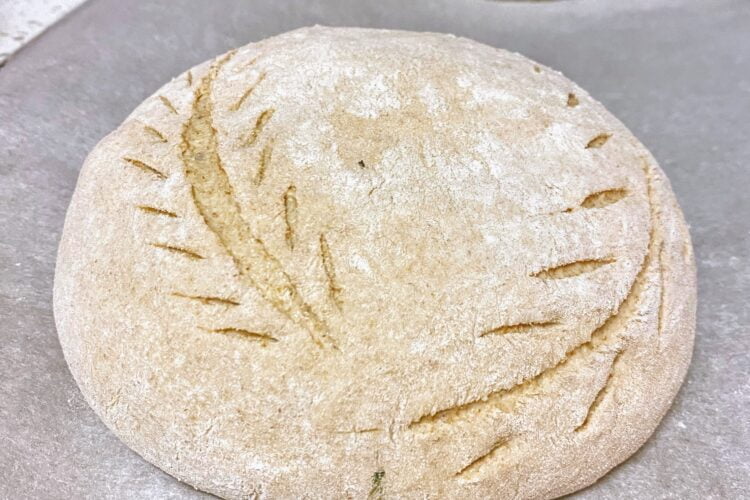Why Do You Score Bread?
Scoring bread is an important step in the bread-making process that involves making shallow cuts on the surface of the dough just before baking. There are several reasons why scoring bread is necessary:
- Aesthetic appeal: Scoring bread creates a decorative pattern on the surface of the loaf, which not only looks visually appealing but also helps to identify the type of bread.
- Controlled expansion: During the baking process, bread dough expands as the yeast produces gas, and the crust forms on the surface. Without proper scoring, the bread may burst or crack in unpredictable ways, affecting its overall appearance.
- Even baking: Scoring allows steam to escape from the bread, which helps to prevent the crust from cracking and promotes even baking. If the bread is not scored, the crust may become too thick and hard, while the inside of the loaf may be undercooked.
- Texture: Scoring helps to control the texture of the bread by directing the way it expands during baking. The cuts allow the bread to rise evenly and create a more open crumb, resulting in a softer, lighter texture.
In summary, scoring bread is essential for achieving a beautiful, evenly baked, and delicious loaf of bread.
What tools are used for scoring?
Several tools can be used for scoring bread, depending on personal preference and the type of pattern you want to create on the bread’s surface. Here are some common tools used for scoring bread:
- Bread Lame: A bread lame is a tool that consists of a handle and a curved blade. The blade is used to make precise cuts on the surface of the bread dough, and the curved shape makes it easier to achieve an angle that directs the dough’s expansion during baking.
- Razor Blade: A sharp razor blade can also be used for scoring bread. It can be mounted on a handle or used freehand to make shallow cuts on the bread’s surface.
- Scissors: Kitchen scissors can also be used for scoring bread. They are an affordable and accessible option and can be used to create different patterns on the bread’s surface.
- Serrated Knife: A serrated knife is another tool that can be used to score bread. While it is not as precise as a bread lame or a razor blade, it can still create a decent pattern on the bread’s surface.
In summary, the tools used for scoring bread include a bread lame, a razor blade, scissors, and a serrated knife. The choice of tool depends on personal preference, the type of pattern desired, and the level of precision required.
What are popular scoring patterns?
there are several popular patterns used for scoring bread. These patterns not only enhance the bread’s appearance but also affect its flavor and texture. Here are some common scoring patterns:
- Single Slash: This is the simplest scoring pattern, where a single straight cut is made down the middle of the bread. It allows the bread to expand evenly and results in a classic, rustic look.
- Cross Slash: This pattern is created by making two perpendicular cuts on the surface of the bread. It creates a more dramatic appearance and also allows for more even expansion.
- Diamond Pattern: The diamond pattern involves making diagonal cuts across the surface of the bread, alternating the direction of the slashes to create a diamond shape. This pattern is popular with French-style baguettes.
- Leaf Pattern: The leaf pattern is created by making several curved slashes in a row, resembling a leaf shape. It is often used for decorative purposes and creates a stunning presentation.
- Boule Pattern: The boule pattern involves making several circular cuts on the surface of the bread, radiating out from the center. This pattern is popular with round loaves, like sourdough boules.
These are just a few examples of the many patterns used for scoring bread. The choice of pattern depends on personal preference and the desired effect. Experimenting with different patterns is an excellent way to create unique and beautiful bread loaves.
Where did scoring tradition came from?
The tradition of scoring bread, also known as “scoring” or “lame-slashing,” has been around for centuries and has its roots in Europe, specifically France. The practice of scoring bread is said to have begun in the 1800s when bakers started to score bread as a way to distinguish their bread from other bakers in the village.
The scoring process serves several purposes. First, it allows the bread to expand and release steam during baking, which creates an open crumb structure and a crisp crust. Additionally, the scoring pattern adds a decorative touch to the bread, making it more visually appealing.
Over time, scoring bread has become a recognized form of bread art, with bakers experimenting with different patterns and designs to make their bread more unique and visually appealing. Today, scoring bread is practiced worldwide and is an essential step in the bread-making process.






[…] Read: How Scoring Affects Flavor? […]